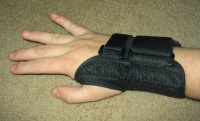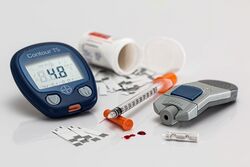Diabetic Neuropathy: Difference between revisions
Chloe Waller (talk | contribs) (Updated references in clinical presentation) |
Chloe Waller (talk | contribs) (Updated symptoms and diagnostic procedures) |
||
| Line 6: | Line 6: | ||
<br> | <br> | ||
== Introduction == | == Introduction == | ||
[[File:Diabetes-528678 960 720.jpg| | [[File:Diabetes-528678 960 720.jpg|250x250px|alt=|thumb]] | ||
Diabetic neuropathy is dysfunction and damage in the peripheral nerves in people with diabetes<ref>Rosenberger DC, Blechschmidt V, Timmerman H, Wolff A, Treede RD. [https://pubmed.ncbi.nlm.nih.gov/32036431/ Challenges of neuropathic pain: focus on diabetic neuropathy.] J Neural Transm (Vienna). 2020 Apr;127(4):589-624.</ref>. [[Neuropathies]] are characterized by a progressive loss of nerve fibre function<ref>Boulton AJ, Malik RA. Diabetic neuropathy. Med Clin North Am. 1998;82(4):909-29</ref>. Diabetic neuropathy is a common complication of [[Diabetes|Diabetes Mellitus]] (DM), estimated to affect up to 51% of patients with both [[Diabetes Mellitus Type 1|type 1]] and [[Diabetes Mellitus Type 2|type 2]] DM<ref name=":1">Hicks CW, Selvin E. [https://www.ncbi.nlm.nih.gov/pmc/articles/PMC6755905/#:~:text=The%20prevalence%20of%20peripheral%20neuropathy,asymptomatic%20to%20painful%20neuropathic%20symptoms. Epidemiology of Peripheral Neuropathy and Lower Extremity Disease in Diabetes.] Curr Diab Rep. 2019 Aug 27;19(10):86.</ref><ref>Dyck PJ, Kratz KM, Karnes JL, Litchy WJ, Klein R, Pach JM, et al. The prevalence by staged severity of various types of diabetic neuropathy, retinopathy, and nephropathy in a population-based cohort: the Rochester Diabetic Neuropathy Study. Neurology. 1993;43(4):817-24</ref>. The clinical presentation of diabetic neuropathy varies, from asymptomatic to severe [[Neuropathic Pain|neuropathic pain]] and numbness<ref name=":1" />. Diabetic neuropathy is associated with increased risk of [[The Diabetic Foot|foot ulcers]], lower limb [[Amputations|amputation]] and mortality<ref name="rayaz">Rayaz A. Malik ;[https://pubmed.ncbi.nlm.nih.gov/24962918/ Which Test for Diagnosing Early Human Diabetic Neuropathy? Diabetes.] 2014;63:[[Tel:2206–2208|2206–2208]]</ref><ref name=":2">Sloan G, Selvarajah D, Tesfaye S. [https://pubmed.ncbi.nlm.nih.gov/34050323/ Pathogenesis, diagnosis and clinical management of diabetic sensorimotor peripheral neuropathy]. Nat Rev Endocrinol. 2021 Jul;17(7):400-420.</ref>. | Diabetic neuropathy is dysfunction and damage in the peripheral nerves in people with diabetes<ref>Rosenberger DC, Blechschmidt V, Timmerman H, Wolff A, Treede RD. [https://pubmed.ncbi.nlm.nih.gov/32036431/ Challenges of neuropathic pain: focus on diabetic neuropathy.] J Neural Transm (Vienna). 2020 Apr;127(4):589-624.</ref>. [[Neuropathies]] are characterized by a progressive loss of nerve fibre function<ref>Boulton AJ, Malik RA. [https://pubmed.ncbi.nlm.nih.gov/9706126/ Diabetic neuropathy]. Med Clin North Am. 1998;82(4):909-29</ref>. Diabetic neuropathy is a common complication of [[Diabetes|Diabetes Mellitus]] (DM), estimated to affect up to 51% of patients with both [[Diabetes Mellitus Type 1|type 1]] and [[Diabetes Mellitus Type 2|type 2]] DM<ref name=":1">Hicks CW, Selvin E. [https://www.ncbi.nlm.nih.gov/pmc/articles/PMC6755905/#:~:text=The%20prevalence%20of%20peripheral%20neuropathy,asymptomatic%20to%20painful%20neuropathic%20symptoms. Epidemiology of Peripheral Neuropathy and Lower Extremity Disease in Diabetes.] Curr Diab Rep. 2019 Aug 27;19(10):86.</ref><ref>Dyck PJ, Kratz KM, Karnes JL, Litchy WJ, Klein R, Pach JM, et al. [https://pubmed.ncbi.nlm.nih.gov/8469345/ The prevalence by staged severity of various types of diabetic neuropathy, retinopathy, and nephropathy in a population-based cohort: the Rochester Diabetic Neuropathy Study]. Neurology. 1993;43(4):817-24</ref>. The clinical presentation of diabetic neuropathy varies, from asymptomatic to severe [[Neuropathic Pain|neuropathic pain]] and numbness<ref name=":1" />. Diabetic neuropathy is associated with increased risk of [[The Diabetic Foot|foot ulcers]], lower limb [[Amputations|amputation]] and mortality<ref name="rayaz">Rayaz A. Malik ;[https://pubmed.ncbi.nlm.nih.gov/24962918/ Which Test for Diagnosing Early Human Diabetic Neuropathy? Diabetes.] 2014;63:[[Tel:2206–2208|2206–2208]]</ref><ref name=":2">Sloan G, Selvarajah D, Tesfaye S. [https://pubmed.ncbi.nlm.nih.gov/34050323/ Pathogenesis, diagnosis and clinical management of diabetic sensorimotor peripheral neuropathy]. Nat Rev Endocrinol. 2021 Jul;17(7):400-420.</ref>. | ||
== Clinically Relevant Anatomy == | == Clinically Relevant Anatomy == | ||
The peripheral nervous system refers to the components of the nervous system outside of the [[Brain Anatomy|brain]] and [[Spinal cord anatomy|spinal cord]]. The nerve roots exit the spinal cord and then branch out into smaller peripheral nerves. The peripheral nerves consist of motor and sensory fibers<ref>Spine-Health. Peripheral Nervous System Anatomy. Available from: https://www.spine-health.com/conditions/spine-anatomy/anatomy-nerve-pain (Accessed 06/07/22). </ref>. | The peripheral nervous system refers to the components of the nervous system outside of the [[Brain Anatomy|brain]] and [[Spinal cord anatomy|spinal cord]]. The nerve roots exit the spinal cord and then branch out into smaller peripheral nerves. The peripheral nerves consist of motor and sensory fibers<ref>Spine-Health. Peripheral Nervous System Anatomy. Available from: https://www.spine-health.com/conditions/spine-anatomy/anatomy-nerve-pain (Accessed 06/07/22). </ref>. | ||
In diabetic neuropathy, | In diabetic neuropathy, there is degeneration in the type, severity, and distribution of these receptors, nerve fibers, or neurons, with the degeneration beginning distally and symmetrically, and spreading proximally<ref name="dyck">Dyck PJ, Herrmann DN, Staff NP, Dyck PJ. [https://www.ncbi.nlm.nih.gov/pmc/articles/PMC3806590/ Assessing decreased sensation and increased sensory phenomena in diabetic polyneuropathies]. Diabetes. 2013; 62:[[Tel:3677–3686|3677–3686]]</ref>. | ||
== Mechanism of Injury / Pathological Process == | == Mechanism of Injury / Pathological Process == | ||
The pathological process of diabetic neuropathy is not completely understood, and is likely multifactoral<ref>Zochodne DW. [https://pubmed.ncbi.nlm.nih.gov/18769245/ Diabetic polyneuropathy: an update]. Curr Opin Neurol. 2008;21(5):527-33</ref>. Research suggests neuronal inflammation, oxidative stress, mitochondrial dysfunction and cell death is caused by hyperglycaemia, dyslipidaemia and microvascular disease<ref name=":2" />. | The pathological process of diabetic neuropathy is not completely understood, and is likely multifactoral<ref>Zochodne DW. [https://pubmed.ncbi.nlm.nih.gov/18769245/ Diabetic polyneuropathy: an update]. Curr Opin Neurol. 2008;21(5):527-33</ref>. Research suggests neuronal inflammation, oxidative stress, mitochondrial dysfunction and cell death is caused by hyperglycaemia, dyslipidaemia and microvascular disease<ref name=":2" />. | ||
[[File:Smoking-1026556 960 720-2.jpg|thumb|250x250px]] | |||
== Risk Factors<ref>Kartha C, Ramachandran S, Pillai RM, editors. Mechanisms of Vascular Defects in Diabetes Mellitus. Springer. 2017. p.163</ref> == | == Risk Factors<ref>Kartha C, Ramachandran S, Pillai RM, editors. Mechanisms of Vascular Defects in Diabetes Mellitus. Springer. 2017. p.163</ref> == | ||
* Poor glycemic control. | * Poor glycemic control. | ||
* High blood pressure | * [[Hypertension|High blood pressure]] | ||
* Smoking. | * [[Smoking Cessation and Brief Intervention|Smoking]]. | ||
* Advance age. | * Advance age. | ||
* Advanced duration of Diabetes disease. | * Advanced duration of Diabetes disease. | ||
| Line 31: | Line 32: | ||
== Clinical Presentation == | == Clinical Presentation == | ||
More than half of the cases are distal symmetric polyneuropathy<ref>Bodman MA, Varacallo M[https://www.ncbi.nlm.nih.gov/books/NBK442009/ . Peripheral Diabetic Neuropathy]. 2022 May 1. In: StatPearls [Internet]. Treasure Island (FL): StatPearls Publishing; 2022 Jan</ref>. Asymmetrical or focal syndromes, such as [[Carpal Tunnel Syndrome|carpal tunnel syndrome]]<ref>Singh R, Gamble G, Cundy T. [https://pubmed.ncbi.nlm.nih.gov/15842519/ Lifetime risk of symptomatic carpal tunnel syndrome in Type 1 diabetes.] Diabet Med. 2005;22(5):625-30</ref> (14-30%), [[Radiculopathy|radiculopathies]]/plexopathies and cranial neuropathies, account for the rest<ref>Shaw JE, Zimmet PZ. [https://research.sahmri.org.au/en/publications/the-epidemiology-of-diabetic-neuropathy The epidemiology of diabetic neuropathy]. Diabetes Reviews. 1999;7:245-52</ref>. | More than half of the cases are distal symmetric polyneuropathy<ref>Bodman MA, Varacallo M[https://www.ncbi.nlm.nih.gov/books/NBK442009/ . Peripheral Diabetic Neuropathy]. 2022 May 1. In: StatPearls [Internet]. Treasure Island (FL): StatPearls Publishing; 2022 Jan</ref>. Asymmetrical or focal syndromes, such as [[Carpal Tunnel Syndrome|carpal tunnel syndrome]]<ref>Singh R, Gamble G, Cundy T. [https://pubmed.ncbi.nlm.nih.gov/15842519/ Lifetime risk of symptomatic carpal tunnel syndrome in Type 1 diabetes.] Diabet Med. 2005;22(5):625-30</ref> (14-30%), [[Radiculopathy|radiculopathies]]/plexopathies and cranial neuropathies, account for the rest<ref>Shaw JE, Zimmet PZ. [https://research.sahmri.org.au/en/publications/the-epidemiology-of-diabetic-neuropathy The epidemiology of diabetic neuropathy]. Diabetes Reviews. 1999;7:245-52</ref>. | ||
The most common symptoms are<ref>Cedars Sinai. Diabetic Neuropathy. Available from: https://www.cedars-sinai.org/health-library/diseases-and-conditions/d/diabetic-neuropathy.html (Accessed 09/07/2022)</ref>: | |||
* Numbness in the hands or feet, often on both sides, described as a stocking-and-glove distribution | |||
* Tingling/"pins and needles" or burning sensation in the feet | |||
* Pain in the hands, feet, or legs | |||
* Dry or cracked skin or calluses on the [[The Aged Foot|feet]]. | |||
* Distal, proximal or more focal weakness, including foot drop or frequent [[Falls|tripping]]. | |||
* | |||
* | |||
== Diagnostic Procedures == | == Diagnostic Procedures == | ||
Testing includes assessment of gross light touch and pinprick sensation. | * Subjective history of symptoms, recent foot trauma and previous ulcers or wounds<ref name=":3">Bandyk DF. [https://www.sciencedirect.com/science/article/abs/pii/S0895796719300110?via%3Dihub The diabetic foot: Pathophysiology, evaluation, and treatment.] Semin Vasc Surg. 2018 Jun-Dec;31(2-4):43-48</ref>. | ||
* Physical examination of skin condition, foot anatomy, and vascular perfusion<ref name=":3" />. | |||
* Testing includes assessment of gross light touch and pinprick sensation, using simple hand held devices (e.g. cotton wool, stick pins or monofilament)<ref name="dyck" />. | |||
Vibratory sense in the feet is tested with a 128-Hz tuning fork placed at the base of the great toenail.< | * Vibratory sense in the feet is tested with a 128-Hz tuning fork placed at the base of the great toenail<ref>American Diabetes Association. Vibration Testing Detects Diabetic Peripheral Neuropathy Earlier than the 10-g Monofilament. Available from: https://professional.diabetes.org/abstract/vibration-testing-detects-diabetic-peripheral-neuropathy-earlier-10-g-monofilament (Accessed 09/07/2022)</ref>. | ||
* Deep tendon [[reflexes]] are commonly hypoactive or absent<ref>Medscape. How are deep tendon reflexes assessed in diabetic neuropathy? Available from https://www.medscape.com/answers/1170337-4949/how-are-deep-tendon-reflexes-assessed-in-diabetic-neuropathy (Accessed 09/07/2022)</ref>. | |||
* Nerve conduction studies or needle electromyogram<ref>Yang Z, Zhang Y, Chen R, Huang Y, Ji L, Sun F, Hong T, Zhan S. [https://www.ncbi.nlm.nih.gov/pmc/articles/PMC6513498/ Simple tests to screen for diabetic peripheral neuropathy. Cochrane Database Syst Rev.] 2018 Jul 30;2018(7)</ref>. | |||
=== Classification === | === Classification === | ||
Diabetic neuropathy can be classified into 4 subgroups:<ref>Endocrine Web. Types of Diabetic Neuropathy. Available from: https://www.endocrineweb.com/guides/diabetic-neuropathy/types-diabetic-neuropathy (Accessed 07/07/2022)</ref> | Diabetic neuropathy can be classified into 4 subgroups:<ref>Endocrine Web. Types of Diabetic Neuropathy. Available from: https://www.endocrineweb.com/guides/diabetic-neuropathy/types-diabetic-neuropathy (Accessed 07/07/2022)</ref> | ||
Revision as of 08:52, 9 July 2022
Original Editor - Wendy Walker
Top Contributors - Sheik Abdul Khadir, Lucinda hampton, Wendy Walker, Kim Jackson, Chloe Waller, Garima Gedamkar, Vidya Acharya, Uchechukwu Chukwuemeka, Amanda Ager, WikiSysop, Ibrahim Khalil and Karen Wilson
Introduction[edit | edit source]
Diabetic neuropathy is dysfunction and damage in the peripheral nerves in people with diabetes[1]. Neuropathies are characterized by a progressive loss of nerve fibre function[2]. Diabetic neuropathy is a common complication of Diabetes Mellitus (DM), estimated to affect up to 51% of patients with both type 1 and type 2 DM[3][4]. The clinical presentation of diabetic neuropathy varies, from asymptomatic to severe neuropathic pain and numbness[3]. Diabetic neuropathy is associated with increased risk of foot ulcers, lower limb amputation and mortality[5][6].
Clinically Relevant Anatomy[edit | edit source]
The peripheral nervous system refers to the components of the nervous system outside of the brain and spinal cord. The nerve roots exit the spinal cord and then branch out into smaller peripheral nerves. The peripheral nerves consist of motor and sensory fibers[7].
In diabetic neuropathy, there is degeneration in the type, severity, and distribution of these receptors, nerve fibers, or neurons, with the degeneration beginning distally and symmetrically, and spreading proximally[8].
Mechanism of Injury / Pathological Process[edit | edit source]
The pathological process of diabetic neuropathy is not completely understood, and is likely multifactoral[9]. Research suggests neuronal inflammation, oxidative stress, mitochondrial dysfunction and cell death is caused by hyperglycaemia, dyslipidaemia and microvascular disease[6].
Risk Factors[10][edit | edit source]
- Poor glycemic control.
- High blood pressure
- Smoking.
- Advance age.
- Advanced duration of Diabetes disease.
- Heavy alcohol intake.
- Tall stature[11]
Clinical Presentation[edit | edit source]
More than half of the cases are distal symmetric polyneuropathy[12]. Asymmetrical or focal syndromes, such as carpal tunnel syndrome[13] (14-30%), radiculopathies/plexopathies and cranial neuropathies, account for the rest[14].
The most common symptoms are[15]:
- Numbness in the hands or feet, often on both sides, described as a stocking-and-glove distribution
- Tingling/"pins and needles" or burning sensation in the feet
- Pain in the hands, feet, or legs
- Dry or cracked skin or calluses on the feet.
- Distal, proximal or more focal weakness, including foot drop or frequent tripping.
Diagnostic Procedures[edit | edit source]
- Subjective history of symptoms, recent foot trauma and previous ulcers or wounds[16].
- Physical examination of skin condition, foot anatomy, and vascular perfusion[16].
- Testing includes assessment of gross light touch and pinprick sensation, using simple hand held devices (e.g. cotton wool, stick pins or monofilament)[8].
- Vibratory sense in the feet is tested with a 128-Hz tuning fork placed at the base of the great toenail[17].
- Deep tendon reflexes are commonly hypoactive or absent[18].
- Nerve conduction studies or needle electromyogram[19].
Classification[edit | edit source]
Diabetic neuropathy can be classified into 4 subgroups:[20]
- Proximal neuropathy/ diabetic amyotrophy.
- Peripheral neuropathy / diabetic nerve pain / distal polyneuropathy.
- Autonomic neuropathy.
- Focal neuropathy / mononeuropathy.
Staging[edit | edit source]
A common staging scale of diabetic neuropathy is as follows: [21]
- N0 - No neuropathy.
- N1a - Signs but no symptoms of neuropathy.
- N2a - Symptomatic mild diabetic polyneuropathy; sensory, motor, or autonomic symptoms; patient able to heel walk.
- N2b - Severe symptomatic diabetic polyneuropathy, and patient unable to heel walk.
- N3 - Disabling diabetic polyneuropathy.
Medical Management / Interventions[edit | edit source]
Medical management starts with 0ptimized glycemic control (mainly for type 1 DM) and lifestyle interventions[22]. Lifestyle intervention includes physical exercise and weight loss.
Tricyclic antidepressants, serotonin-norepinephrine reuptake inhibitors (e.g. duloxetine) and anticonvulsants (e.g. pregabalin and gabapentin) are commonly prescribed treatments for neuropathic pain[23]. At present, there are no universally accepted disease modifying medicines, but this is currently being researched and developed[24].
Moreover, multidisciplinary team management is required for the prevention and management of diabetic foot complications[6].
Physiotherapy Management and Exercise[edit | edit source]
Research has shown that strength training can moderately improve muscle function in people with peripheral neuropathy (PN). Regular exercise can also help reduce neuropathic pain and help control blood sugar levels.[25] Diabetic clients must tightly monitor their blood sugar levels during exercise to prevent major fluctuations. This may involve educating clients and monitoring blood sugars, ideally through a multi-disciplined approach in rehabilitation.
Specific exercise programs should include[edit | edit source]
- Flexibility (progressive stretching and self stretches)
- Muscle strengthening ( using a variety of modes as appropriate eg isometric, graded weight progression, open and close chain)
- Aerobic activity ( aiming for 30 minutes 4 times a week)
- Balance ( for falls prevention and stability)
- Gait (can improve gait pattern or walking in patients with diabetic neuropathy) Evidence shows that resistant strengthening exercises lower blood glucose level[26]
The youtube below shows some good exercises that a physiotherapist can employ to help manage the symptoms of diabetic neuropathy.
A 2014 review found that the biggest consequence of diabetic neuropathy was a increase in risk of falls. [28] Therefore balance and falls prevention programs and or training, in the senior diabetic clientele in particular, by a physiotherapy is very beneficial.
Physiotherapy may also involve splinting for mononeuropathies eg. carpal tunnel or for muscle weakness eg Ankle foot orthoses.[25] 
As a consequence of diabetic neuropathy physiotherapist are involved in
The Diabetic Foot.
The Diabetic Amputee.
Physiotherapeutic Management of Pain in Diabetic Neuropathy[edit | edit source]
see also Nerve Injury Rehabilitation Physiotherapy
Evidence has been provided for:
- Transcutaneous Nerve Stimulation (TENS)[30]
- Static magnetic field therapy
- Low-intensity laser therapy
- Monochromatic infrared light
Differential Diagnosis[edit | edit source]
Other possible causes of neuropathy include[31]:
- Autoimmune disorders (e.g. Guillain-Barré syndrome, systemic lupus erythematosus, and rheumatoid arthritis)
- Inherited disorders (e.g. Charcot-Marie-Tooth Disease)
- Infections (e.g. chicken pox, HIV, hepatitis c and Lyme disease)
- Alcoholism
- Vitamin deficiency (e.g. vitamins B1, B6, B12, vitamin E and niacin)
- Trauma
- Toxins (e.g. heavy metals and industrial chemicals)
- Medications (e.g. some antibiotics or chemotherapy)
- Hypothyroidism
- Vascular disorders.
References[edit | edit source]
- ↑ Rosenberger DC, Blechschmidt V, Timmerman H, Wolff A, Treede RD. Challenges of neuropathic pain: focus on diabetic neuropathy. J Neural Transm (Vienna). 2020 Apr;127(4):589-624.
- ↑ Boulton AJ, Malik RA. Diabetic neuropathy. Med Clin North Am. 1998;82(4):909-29
- ↑ 3.0 3.1 Hicks CW, Selvin E. Epidemiology of Peripheral Neuropathy and Lower Extremity Disease in Diabetes. Curr Diab Rep. 2019 Aug 27;19(10):86.
- ↑ Dyck PJ, Kratz KM, Karnes JL, Litchy WJ, Klein R, Pach JM, et al. The prevalence by staged severity of various types of diabetic neuropathy, retinopathy, and nephropathy in a population-based cohort: the Rochester Diabetic Neuropathy Study. Neurology. 1993;43(4):817-24
- ↑ Rayaz A. Malik ;Which Test for Diagnosing Early Human Diabetic Neuropathy? Diabetes. 2014;63:[[1]]
- ↑ 6.0 6.1 6.2 Sloan G, Selvarajah D, Tesfaye S. Pathogenesis, diagnosis and clinical management of diabetic sensorimotor peripheral neuropathy. Nat Rev Endocrinol. 2021 Jul;17(7):400-420.
- ↑ Spine-Health. Peripheral Nervous System Anatomy. Available from: https://www.spine-health.com/conditions/spine-anatomy/anatomy-nerve-pain (Accessed 06/07/22).
- ↑ 8.0 8.1 Dyck PJ, Herrmann DN, Staff NP, Dyck PJ. Assessing decreased sensation and increased sensory phenomena in diabetic polyneuropathies. Diabetes. 2013; 62:[[2]]
- ↑ Zochodne DW. Diabetic polyneuropathy: an update. Curr Opin Neurol. 2008;21(5):527-33
- ↑ Kartha C, Ramachandran S, Pillai RM, editors. Mechanisms of Vascular Defects in Diabetes Mellitus. Springer. 2017. p.163
- ↑ Kote GS, Bhat AJ, Thajuddeen K, Ismail MH, Gupta A.Peripheral Insensate Neuropathy-Is Height a Risk Factor? J Clin Diagn Res. 2013; 7(2): 296–301
- ↑ Bodman MA, Varacallo M. Peripheral Diabetic Neuropathy. 2022 May 1. In: StatPearls [Internet]. Treasure Island (FL): StatPearls Publishing; 2022 Jan
- ↑ Singh R, Gamble G, Cundy T. Lifetime risk of symptomatic carpal tunnel syndrome in Type 1 diabetes. Diabet Med. 2005;22(5):625-30
- ↑ Shaw JE, Zimmet PZ. The epidemiology of diabetic neuropathy. Diabetes Reviews. 1999;7:245-52
- ↑ Cedars Sinai. Diabetic Neuropathy. Available from: https://www.cedars-sinai.org/health-library/diseases-and-conditions/d/diabetic-neuropathy.html (Accessed 09/07/2022)
- ↑ 16.0 16.1 Bandyk DF. The diabetic foot: Pathophysiology, evaluation, and treatment. Semin Vasc Surg. 2018 Jun-Dec;31(2-4):43-48
- ↑ American Diabetes Association. Vibration Testing Detects Diabetic Peripheral Neuropathy Earlier than the 10-g Monofilament. Available from: https://professional.diabetes.org/abstract/vibration-testing-detects-diabetic-peripheral-neuropathy-earlier-10-g-monofilament (Accessed 09/07/2022)
- ↑ Medscape. How are deep tendon reflexes assessed in diabetic neuropathy? Available from https://www.medscape.com/answers/1170337-4949/how-are-deep-tendon-reflexes-assessed-in-diabetic-neuropathy (Accessed 09/07/2022)
- ↑ Yang Z, Zhang Y, Chen R, Huang Y, Ji L, Sun F, Hong T, Zhan S. Simple tests to screen for diabetic peripheral neuropathy. Cochrane Database Syst Rev. 2018 Jul 30;2018(7)
- ↑ Endocrine Web. Types of Diabetic Neuropathy. Available from: https://www.endocrineweb.com/guides/diabetic-neuropathy/types-diabetic-neuropathy (Accessed 07/07/2022)
- ↑ Dianna Quan,Helen C Lin ; Diabetic Neuropathy Clinical Presentation. Available from: http://emedicine.medscape.com/article/1170337-clinical#a0256 (Accessed 26 May 2020)
- ↑ Cernea S, Raz I. Management of diabetic neuropathy. Metabolism. 2021 Oct;123:154867.
- ↑ Callaghan BC, Gallagher G, Fridman V, Feldman EL. Diabetic neuropathy: what does the future hold? Diabetologia. 2020 May;63(5):891-897.
- ↑ Røikjer J, Mørch CD, Ejskjaer N. Diabetic Peripheral Neuropathy: Diagnosis and Treatment. Curr Drug Saf. 2021;16(1):2-16.
- ↑ 25.0 25.1 The Foundation for peripheral neuropathy. Exercise and physical therapy for neuropathy. Available from: https://www.foundationforpn.org/living-well/lifestyle/exercise-and-physical-therapy/ (last accessed 10.3.2019)
- ↑ The daily star. Physiotherapy for diabetic neuropathy. Available from: https://www.thedailystar.net/health/how-to-prevent-diabetic-neuropathy-by-physiotherapy-1512505 ( accessed 10 April 2019)
- ↑ Physical Therapy Video. Peripheral neuropathy relief in the feet and legs. Available from: https://www.youtube.com/watch?v=n23mUQexmKw (accessed 9 March 2019)
- ↑ Pan X, Bai JJ. Balance training in the intervention of fall risk in elderly with diabetic peripheral neuropathy: A review. International Journal of Nursing Sciences. 2014;1(4):441-5. Available from: https://www.sciencedirect.com/science/article/pii/S235201321400091X (accessed 9 March 2019)
- ↑ Physical Therapy Video. 7 balance exercises for seniors fall prevention. Available from: https://www.youtube.com/watch?v=BNC4bi3Ucac (accessed 9 March 2019)
- ↑ Hamza MA, White PF, Craig WF, Ghoname ES, Ahmed HE, Proctor TJ. Percutaneous electrical nerve stimulation: a novel analgesic therapy for diabetic neuropathic pain. Diabetes Care. 2000; 23:365 -370.
- ↑ Cleveland Clinic. Neuropathy. Available from: https://my.clevelandclinic.org/health/diseases/14737-neuropathy (Accessed 07/07/22)









